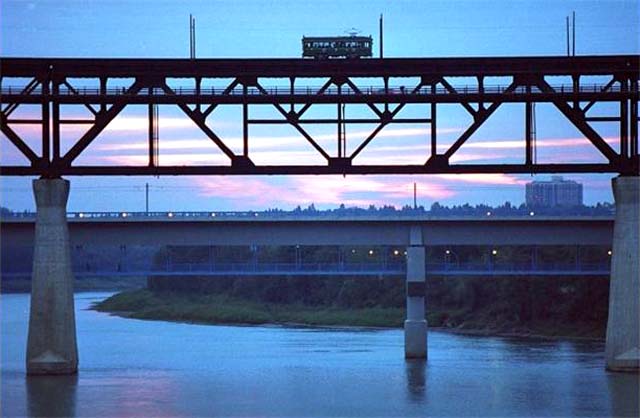
2012
|


The old trolley trundles across the High Level Bridge in front of the setting sun - 2004 John
Lucas.
24 August 2012
High Level the Bridge That Refuses to Fall
Edmonton Alberta - On summer mornings in the 1920s, I would wake to the sound of the High Level Bridge. The hollow clop-clop-clop of
horses treading the wooden blocks that paved the traffic deck carried far and clear when the wind was light and the air heavy with dew.
The wake-up calls ceased at 7 a.m. when the horses that powered bread wagons, milk wagons, ice wagons, farm wagons, moving vans, and commercial drays had to
clear the bridge for motor traffic, though there wasn't much of that. Edmonton at the time needed only one set of traffic lights, at First and Jasper.
Our apartment was perched on the hillside, on half a lot, at the end of 113th Street. In summer, the window of the bedroom I shared with younger brothers John
and George was open to the sounds of the bridge. In all seasons, it brought views of the valley, through the ritual cycle of green turning to gold, then
charcoal, and green again.
The scene has since become available to a larger audience. Our place on the hillside, a wooden house that had been converted to five apartments, has been taken
by 14 storeys of steel and concrete known as The Valhalla.
There have been only two notable deletions from the scene, the Royal Glenora Club sits on the site of the former Chinese market garden and a hiking trail on the
route of the former Edmonton Yukon & Pacific Railway. But the wooden steps still descend to the baseball diamond and the golf course. Halfway down, they
pass the elevated 13th green, which became a toboggan slide in winter. The sky is as high and sunsets as wide, but when night falls the bridge is no longer
dramatic.
Darkness, like many things, is not what it used to be. Haze that swallows the stars flows from high rise buildings where lights burn all the time, from more
than 90,000 street lights where there used to be one light at corners. The one set of traffic signals at First and Jasper has multiplied to all horizons,
blinking green, yellow, and red into the haze.
In the window of our bedroom, darkness was absolute. Across the valley, specks of light flickered among the trees of Garneau. On some evenings, flashes of
automobile headlights from the campus would tell us there was a happening at Convocation Hall.
But all through every night, the High Level Bridge sparkled with a chain of strong white lights, stretching cliff to cliff. They were mounted on the pedestrian
walks, and their long white beams casting east and west were part of the bridge's identity. Until about 1950, that is, when the city's traffic engineers got
involved. They observed that the iconic lamps shed little light on the traffic deck, so they decided they no longer served a purpose and snuffed them out.
While Edmonton's signature bridge loomed large by night or day, it ought to have fallen down in 1934, according to Werner Mueller. Mueller's dire prediction
was based on vibrations, beginning at 1:02 p.m., 2 Jun 1913, when the last rivet was driven. He calculated that vibrations of the stars, along with vibrations
of trains, wagons, and automobiles, would conspire to send the mammoth structure crashing into the valley on 1 Nov 1934, at 6:53 p.m.
Mueller warned the city council, the Canadian Pacific Railway, the editors of the Edmonton Journal, the Edmonton Bulletin and washed his hands of
responsibility for anything that happened to trains or citizens on the bridge at the awful moment.
Editors took the danger lightly but couldn't pass up a good story, and as the awful moment approached, 300 would-be spectators gathered on the site of the
future Ezio Farone Park, the best spot to view the catastrophe.
A less adventurous crowd stayed back around the curling rink on the far side of 97th Avenue. If Mueller was right, they didn't want to be too close. Tension
mounted as time moved inexorably toward the moment. The moment was near... the moment was at hand... the moment passed... and the bridge stood tall.
But through the night, 122 concerned citizens phoned the Journal, inquiring about the health of the High Level.
Meanwhile, Mueller was back among his charts, looking for the error in his calculations.
When he found it, he sent the revised bad news: The bridge would take the plunge the next morning at 5:36 a.m. Again it defied the vibrations and
Edmonton settled back to its usual calm.
But we hadn't heard the last of Mueller. The year 1935 was barely underway when he emerged with a prediction even more dire. The bridge would fall on Friday,
25 Jan 1935, at 2:26 p.m. and the Alberta legislature would collapse at the same moment.
Would the falling dome crush the offices beneath, with all who worked there?
As 25 Jan 1935 turned to afternoon, some nervous civil servants decided not to find out. But two blocks away, in the Grade 7 room at Grandin School, the mood
was creepy anticipation. We didn't think it was really going to happen, but if it did we didn't want to miss the sound of the hideous crash.
The few kids with watches kept vigil. Through knowing looks and telepathy, we knew when the afternoon had reached 2 p.m., less than half an hour to go. A
quarter past two. Tension mounted. Our teacher, Mother Antoinette, was a lively lady, keenly aware of what was going on in the world and in the school. She
understood and accepted that the Wars of the Roses (or whatever subject) couldn't compete with a disaster in which two Edmonton landmarks would fall to pieces.
As the fatal moment approached, she put the history lesson on hold and joined the listening. The moment passed. She smiled with a knowing shrug and resumed
business as usual. And ever since, it's been business as usual at Grandin School, the legislature, and the High Level Bridge.
Tony Cashman.

|


|
Vancouver Island
British Columbia
Canada
|
|


